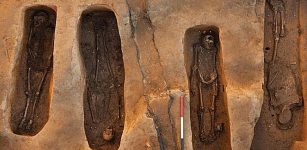Mysterious Ancient Inscription With Unknown Language Found Near Lake Bashplemi, Georgia
Jan Bartek - AncientPages.com - A recent discovery near Lake Bashplemi in Georgia's Dmanisi region offers compelling evidence of languages yet to be understood by scientists. An ancient basalt tablet, inscribed with an unknown language, has been unearthed and is believed to date back to the Late Bronze Age or early Iron Age, around the first millennium B.C. This find is not only rare due to its material but also holds the potential to unlock new insights into the ancient civilizations that once thrived in the Caucasus.
The tablet, comparable in size to a book, features 60 distinct symbols—39 of which are unlike any known ancient writing systems. These unique symbols are meticulously arranged across seven horizontal lines. The repetition and patterning of some characters hint at possible numerical or punctuation functions.
While initial interpretations suggest this writing system might have documented religious offerings, construction projects, or military inventories, these ideas remain speculative.
The site of the discovery is situated at Lake Bashplemi in Georgia. Credit: R. Shengelia et al.
Ancient artisans used advanced techniques, such as a conical drill for initial outlines and rounded tools for smoothing, to create these characters.
The basalt's hardness and precise markings highlight their skill. Scientists noticed that the inscription partially resembles ancient writing systems, sharing similarities with Caucasian scripts like early Georgian alphabets and pre-Christian scripts. Some symbols evoke Near Eastern systems such as Phoenician, Aramaic, and Proto-Sinaitic, suggesting cultural influence or exchanges with neighboring civilizations.
Lake Bashplemi in Georgia. Credit: R. Shengelia et al.
The Bashplemi inscription doesn't fully match any known writing system. Its symbols partially resemble Semitic, Greek, Indian systems, and some Bronze and Early Iron Age seals in Georgia. This peculiarity suggests it might be an independent or locally evolved proto-system.
The symbols on the tablet are highlighted and sequentially numbered. Credit: R. Shengelia et al.
This sign system adds complexity to the Caucasus's cultural history, a region at the crossroads of Asia and Europe but often seen as peripheral in ancient writings.
Ancient authors like Apollonius of Rhodes mention "golden writing" in Colchis (now western Georgia), but no conclusive evidence exists until now. This discovery suggests other writing systems may have existed in the Caucasus during the Bronze Age for ceremonial or administrative purposes. The lack of preserved samples might be due to biodegradable materials like wood or leather not surviving humid climates.
A tablet with an inscription in an unidentified language was discovered in Georgia, within the Caucasus region. Credit: R. Shengelia et al.
Shiraki (South-east Georgia) seals (13 BC–11 BC). Credit: R. Shengelia et al.
An analysis confirmed material authenticity and inscription techniques: basalt matches local geology, indicating local production. Wear marks from metal tools suggest locals attempted cleaning, reinforcing authenticity.
The complex inscription process requiring technical skill makes modern forgery unlikely; archaeologists base authenticity on the archaeological context resembling other regional pre-Christian signs.
See also: More Archaeology News
The Dmanisi region is renowned for its archaeological significance, particularly human remains dating back 1.8 million years that illuminate early Eurasian history.
Yet this discovery shifts focus from physical anthropology to a potentially groundbreaking writing system that could unravel mysteries about the culture, religion, and social structures of its ancient inhabitants. This tablet stands as a pivotal key in understanding our shared human past—an opportunity we cannot afford to overlook.
The study was published in the Journal of Ancient History and Archaeology
Written by Jan Bartek - AncientPages.com Staff Writer


























